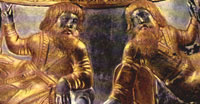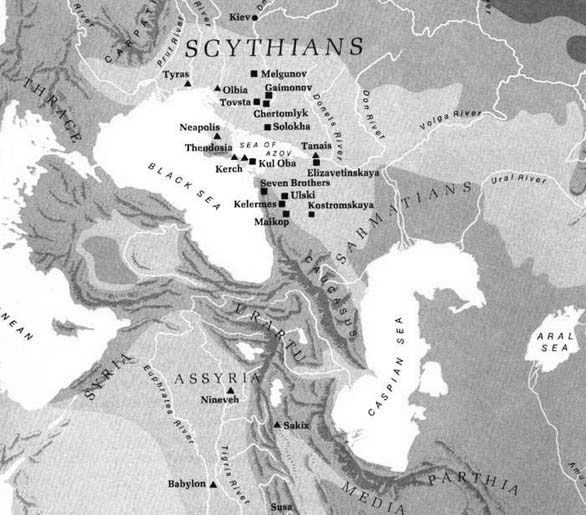Co-editors: Seán Mac Mathúna • John Heathcote
Consulting editor: Themistocles Hoetis
Field Correspondent: Allen Hougland
E-mail:
editors@fantompowa.net
Vladimir Pomakov
The
Scythians, Sarmatians, Meotians, Russians and Circassians:
Interpretation of the Ancient
Cultures
by Sergei V. Rjabchikov The
Scythians: High-plians drifters Book
Reviews of The Thirteenth Tribe Review
of Arthur Koestler's Book The Thirteenth Tribe by Grace
Halsell The
Jews of Khazaria by Kevin Alan Brook The
Medieval Jewish Kingdom of the Khazars,
740-1259 Khazaria.com:
A Resource for Turkic and Jewish History in Russia and
Ukraine Regarding history one of the
most profound Bulgarian historians, Dr. Gancho Tzenov, prof.
at the University of Berlin in the beginning of 20th
century, believed that: (1) history is a positive, inductive
science, which is based only on facts, systematized facts
and never on assumptions, opinions and speculations.
Consequently one must not believe in histories written by
victors; (2) large sections of the officially accepted at
his time European history of the past 2000 years or so, and
particularly that of Eastern Europe, is based on
assumptions, opinions and speculations and has nothing in
common with the real history of the continent and its human
inhabitants. The situation has not changed as of today.
There is a lot of evidence supporting this stand of Dr.
Tzenov, but I will allow myself to adduce the following few
from his works: 2. The legend, as told by
Herodotus, have it that all "Scythians" were direct
descendants of Hercules who had three sons from a
mythical beast whose lower part was snakelike, and whose
upper part was one of a hermaphrodite. Of this, let's
call it 'marriage', the Hermaphrodite bore three sons:
Agatirz, Gelon and Skit. (Readers will probably be aware
that Hercules himself has nothing to do with the
so-called Greek mythology and the Greek pantheon simply
because he was a Thracian God much, much more ancient
than the whole gang at Olympus Mountain.) 3. The Hercules' first son,
called by Herodotus "Aga-tirz", was called by the people
that descended from him "KOZAR". The Greek word "Agatirz"
means "Goat-hunter" and is again a direct translation of
the ethnonym "KOZAR" (goat-keeper or goat-hunter). Later,
in the middle ages, in parallel with the changes in the
Greek language, the pronunciation of the name of these
peoples also changed and become "akatziri", "agatziri" or
"agaziri". Something similar happened to the native,
proto-Slav, name and it changed from "KOZAR" to "KOZAK"
("cossack"). (In antiquity, as partly in present days,
they lived in the Carpathian Mountains, just to the north
of the Lower Danube.) 4. In the 6th century AD,
the Anonymous Chronograph of Ravenna, in its brief
description of the KHAZARS, as one of the major peoples
inhabiting Skitia (Scythia), specifies that, in the
ancient times, they were called "akatzirs": "In portione autem Iaphet
filii Noae, quam philosophi Europam appellaverunt,
sistuntur patriae, id est patria que dicitur Scythia,
quae in omnibus cremosa existit. Ponitur ipsa patria
litus Oceanum septentrionalem juxta prefatos montes
Rimphaeos, quae patria longe lateque spatiosissima esse
dinoscitur, item ponitur in locis planiciis longe lateque
nimis spatiosissima quae dicitur Chazariae, et usque
maior Scythia appellatur, quam Iordanis Cosmographus in
modum Fungi scarifum esse dixit, quos Chazaros supra
scriptus Iordanis Agaziros vocat per quam Chazarorum
patriam plurima transeunt Flumina, inter cetera Fluvius
maximus qui dicitur Cuphis. - Ravennati Anonymi
Cosmographia ed. M. Pinder et G. Parthey. Berolini, 1860,
p. 158 (IV-1)." (In that part which the
philosophers called Europe the fatherland of Iafet,
Noah's son was located, i.e. a fatherland named Scythia,
which is a wasteland (or abandoned land). This fatherland
was located along the coast of the Northern Ocean by the
mentioned before Rimphean Mountains and was very big by
width and by length. Also, in a place flat, too spacious
in length and width is the so called Chazaria, which was
constantly called the Big Scythia, about which the
geographer Jordanes tells that was in the shape of a
mushroom. Those Chazars the above-mentioned Jordanes
calls Agazirs. Through this fatherland of the Chazars
flow many rivers, of which the largest one is called
Cuphis). 5. Thus, for the first time,
it was documented that the "KHAZARS" were the same
"AGATZIRS", the same ancient Scythian, or Kelto-Scythian
tribe "AGA-TIRZ", or as they called themselves in
Herodotus time, "KOZARS". (Therefore, all this about the
Khazars being Turkic, or Turkic-Caucasian (!) tribe was
pure nonsense. The very term "Turkic-Aryan" is impossible
and is in itself a transcendent folly. The Khazars, or
KOZARs, or KOZAKS (COSSACKS) as they called themselves in
more recent times, were one of the most ancient European
peoples, the remnants of which, after Stalin's very
successful attempt at their extermination, still inhabit
today's Ukraina and Russia.) 6. What West-European
historians (and most of East-European ones as well) call
The Great Migration of Peoples in the early Middle Ages -
between 4th and 7th AD - implying that huge masses of
people from the depth of Asia, predominantly of Turkic
origin, rushed into Europe and turned everything on their
way into ruins, is to a very large extent dramatic
fiction, myth, fabrication. What actually took place in
the above period (and even as early as by the end of the
3rd century AD) was the dislocation and transposition of
the different Scythian (Skitian if we would prefer the
correct form) peoples within their vast European range.
This tremendous movement of human masses was due to a
large extent to overpopulation of their traditional home
territories where the life supporting resources have
become more or less exhausted. Thus the northern, Baltic
Skitians (for instance the notorious Goths!) moved south,
displacing those living in the more southern latitudes,
who in turn pushed their neighbours further south.
Similarly, there were movements along the parallel, like
the one performed by the tribes of Huns. They left their
homeland around Azov sea (Meothida) and moved westwards
displacing, but mostly conquering their cousins, the
Kozars and a few more of the Danube Valley Skitian
peoples. 7. The Danube was generally
the northern state border of the Roman Empire. Skitians
inhabiting the lands on its right-hand riverside were
subjects to the Roman Emperor. Skitians living on the
river left-hand riverside were more or less "free" and
were frequently called "barbarians" by their cousins and
by other peoples living within the borders of the Empire.
However, the Empire tried to exact tribute from them, too
and in more than one way had made itself hated and
non-welcomed by the free Skits. This obviously was one of
the most important reasons to have many Skitian tribes
united in the first half of the 5th century AD under the
scepter of one of their kings in order to govern
themselves in the way that would suit them best. It so
happen that that king was called Attila (a Romanized form
of a traditional and popular in the past Bolgarian name -
Tilko). There are many ancient authors who wrote that the
Huns were part of the Skitians (Claudius Ptolemeus,
Philostorgius, Zosimus, etc.) and had nothing to do with
the Turkic tribes. One of the most important of them was
the Roman military leader Priscus. He was sent to Attila
on a state mission by the Emperor and upon his return to
Rome presented an extensive report on his visit to the
"King of Skitians", although once or twice in his report
he calls his hosts Huns, too. Prokopius identified the
Huns with the mythical Cimmerians and Masageths, the same
Skitian people that defeated ultimately the Persian Czar
Cyrus. (Where from, then, did such a crazy notion came to
some learned heads of historians, that the Huns were
Asiatic, Turkic, undersized, bowlegged, stinking
half-humans, drinkers of raw mare-milk and little short
of being man-eaters, who threw the cultured, noble Roman
citizens - who indulged in gladiatorial skirmishes in the
circuses - in horror? The best advice to this scholars
would be to have them read again and again the Priscus'
report and make up for themselves a true picture of what
the Huns were!). 8. (Now, Huns and Kozars
(Khazars) were very close relatives, if not one and the
same people. Both Huns and Khazars, or the part of the
Danube Skitians they were, formed together with other
Skitian tribes the Bolgarian people, state and nation
south of the Danube. It is very possible that when
Kozars/Khazars started leaving their homeland because of
the overpopulation, they moved in more than one
direction: i.e. while part of them went south, crossed
the Danube and entered Mysia and Thracia, where they
mixed with their kinsmen there, another part may had
moved eastwards towards the plains between the Black and
Caspian seas and mixed with the Skitians inhabiting those
lands, may be as far south as the Caucasus Mountains.
Probably it was in this way that the tale of the
Volga-Kama Bulgaria was born. It is possible that some of
them may have been converted to Judaism by the mountain
Jews from Caucasus, but the notion that almost the whole
of the contemporary Jewry, particularly the Jews from
Russia, Poland, the Baltic States - the East Europe in
general - originated from the Kozars/Khazars is right
away improbable. Jews of definitely Semitic origin have
lived in Bulgaria for at least 1000 years. They arrive
here in greater numbers after they were driven away from
Spain by the end of 15th century AD. Most of the
Ashkenazim Jews settled in Bulgaria by the end of 19th
century AD, when the country was already liberated from
the Otoman rule, but no doubt there were many who had
come to live here while the country was still within the
Otoman Empire. As a whole Ashkenazim Jews were richer and
of higher may be social status than the Sepharadim ones
but one can hardly doubt in their Semitic
origin.) 9. There is considerable
evidence that the "famous" writing - the travel notes -
of the Arab traveler Ibn Fazlan (or Fadlan? - 9th or 10th
century AD?), on which all of the later Arabic
"historical works" on Volga Bolgars, Khazars, etc. were
based, has never been found in its original form - only
copies of copies of copies! The careful analysis of these
'travel notes' reveals that he had simply cribbed almost
everything from Priscus report on his visit to Attila in
the first half of 5th century AD. It is understandable when
politicians want to have such a history that will serve in
the best possible way their political goals and interests.
It is understandable when victors in a war want to present
the story of this war in such a way as to show themselves in
the best possible light, not the least to cover the
multitude of atrocities they have consciously and
intentionally committed. However, all this has nothing to do
with History as a Science. It should be the First and Most
Important Obligation of all those vociferous advocates of
justice, truth, etc. to have first of all THE WHOLE OF THE
HISTORICAL TRUTH, irrespective of the effect this could have
on the current or future politics. Now, here is indeed an
impossible thing to achieve, isn't it! Vladimir Pomakov is a writer
from Bulgaria. He can be contacted c/o Flame the e-mail
address above.


An
example of Scythian art: The Scythians are the common
ancestors of the Indo-European people - including the
people of Ireland, where according to the traditions
of the Lebor Gabala Erren (Book of the Taking
of Ireland), the Irish originated in Scythia and were
descendants of a King Feinius Farsaid, a King of
Scythia. For more on this check Irish
mythology - the legendary descent of the Irish
Clans.
1. Herodotus wrote
extensively on the Scythians - the common ancestors of
most of Indo-European peoples. He noted that this was the
name they used to call themselves and that it translates
in Greek as Nomads, or "wanderers". This is almost a
direct proof that the tribes he describes under the
common name of "Scythians" were proto-Slav peoples and
that the name was derived from the Slav word "skitati"
meaning "wander", "roam" (and thence the derivative word
"skiti" - wanderers). Herodotus roughly outlined the
territory inhabited by "Scythians": from the German
mountains (Schwarzwald) in the west to the Black sea in
the east and from the Baltic region in the North to the
Mediterranean in the south. This was more or less half
the known world at his times. What were the peoples that
inhabited the world beyond these boundaries Herodotus did
not say. (This was revealed and proven only now, in the
20th century AD, by the archeological findings in West
China, Xin-jiang Province, in Mongol-Bouryatia, around
lake Baikal, and in the vast lands between the Altai and
Hindu Kush mountains. There archeologists excavated
scores of mummies of Indo-European race, some of them as
old as 5000 years and resembling very closely the peoples
abiding the Atlantic coast roughly at the same time.
Unfortunately Dr. Tzenov died in 1952). A number of the
ancient authors often called the "Scythians"
"K(C)eltoscythians", too. Among the "keltoscythian"
peoples they mentioned "Gog", "Magog", "Geti",
"Masageti", "Cimmerians", etc. (Today's historians regard
the "Scythians" as a long extinct people, of whom only
legends and some artifacts are left. However, ancient
Skitians' gene stock is as alive today as it was 5 or 10
thousand years ago, being passed through Thracians,
Illyrians, Dacians, etc., etc., into the present day Slav
nations all over Central, Southeast and East Europe, and
possibly into some other, unexpected ethnic
group.)

Map showing the
lands populated by the Scythians - they almost completely
correspond with the state of the Khazars. From the
The
Scythians
web
site.
